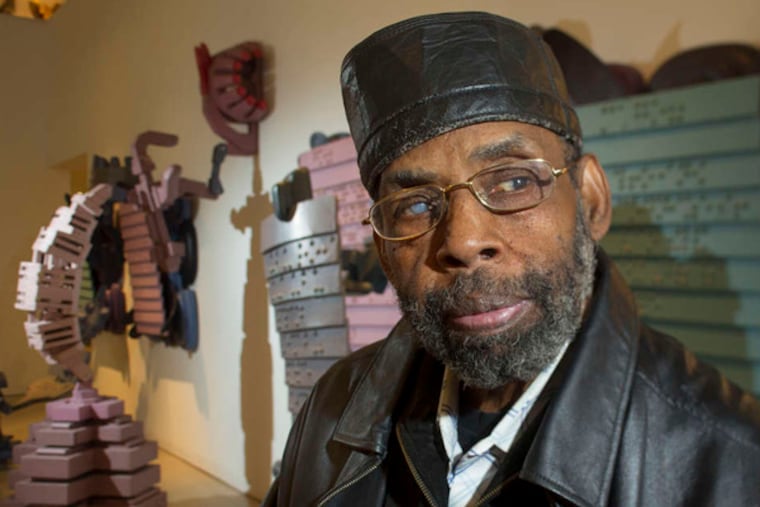Legally blind, sculptor David Stephens continues to make art
David Stephens, at 72 years of age, is a man quietly on a mission - to not let anything keep him from his art.

David Stephens, at 72 years of age, is a man quietly on a mission - to not let anything keep him from his art.
In his exhibition "Auguries of Idolatry" at the Center for Art in Wood, his sculptures loom large, some of them 9 feet tall. The wooden altars are devoted to Stephens' deceased family members, ancestors, and acquaintances, flanked by structures that resemble stools made for offerings.
Declared legally blind in 1979 due to glaucoma, the renowned Philadelphia artist continues to produce works that reveal a dynamic, sharp vision.
"I visualize my work mentally like someone who can see; you conceptualize it," said Stephens. "For the most part, I work alone, but sometimes with assistance to mix colors and grid the braille."
In "Idolatry," he encapsulates many perspectives on diverse religious practices, issues surrounding idolatry from a biblical premise, and African and Western concepts of leadership, royalty, and materialism.
The braille inscribed on panels above the stools read "alms for Allah, bucks for Buddha, change for Christ" on one side and "ducats for Damballah" and "essence for Esther" on the other.
Stephens' own religious upbringing was richly diverse.
"To a great extent, I was raised by three very religious women who were AME Zion," said Stephens. "My immediate family eventually converted to Catholicism and I attended a Catholic boarding school. By the time I was a teenager, I had thoroughly read the King James and Douay-Rheims versions of the Bible until both copies were dog-eared."
But, he adds, "My work relates to culture, history, and personal interest more than religion itself."
Stephens said he works on several pieces at a time. The four large-scale works in "Auguries of Idolatry" were five years in the making, created in his studio at home and assembled at the gallery.
Stephens says his next artistic evolution is "to transfer from making sculptural objects to creating landscape architectural structures using braille at different sites."
His braille garden will be featured this summer at the Slought Foundation in West Philadelphia.
"He has long been interested in large-scale sculptural applications of braille," said Aaron Levy, executive director and senior curator at the Slought Foundation. "In recent years, he has developed a series of designs and prototypes for gardens in Philadelphia that would involve shaping earth into braille forms."
In 1971, he was featured in Art International, Art in America, and Artforum as a talent to watch. By today's standards, that type of attention would mark him as an emerging superstar.
"David had something to say about everything and during his years in D.C., from 1971 to 1979, he was king of the art scene," says colleague and art historian Teresia Bush.
But Stephens says he never courted the limelight, preferring to focus on supporting other artists. "I sought ways to help other artists," he said. "Because of my training, in part, at Howard University, we did things for each other. I mentored other artists [throughout my career]."
Stephens taught at the University of Baltimore and the Corcoran Gallery of Art, and served as a program officer at the Pennsylvania Council on the Arts.
Born in Washington, D.C., and raised for the most part in Philadelphia, Stephens' lifelong trek took him from Baltimore to Philadelphia to New York and back to D.C. Married at the time, he and his wife were well-known for their parties before parting ways in 1979.
Invited by Brandywine Workshop founder Allan Edmunds to work as program director, he returned to Philadelphia, now his permanent home.
Stephens has handled life's ups and downs with aplomb.
He was diagnosed with glaucoma in 1974, able to still see the finest print at the time. By 2001, he could only detect movement.
"It did not take adapting to," he said matter-of-factly. "I just went on with my life."
He eventually attended the Blind Institute and Services of Maryland, where he learned braille and blind mobility.
"I did not feel one way or the other about the experience - no emotion; it was just training and learning."
After exploring color-field painting and myriad styles, Stephens switched to biblical themes in 1991. His current work references biblical sources, much like that of visionary artist James Hampton, whose Throne of the Third Heaven of the Nations' Millennium General Assembly, made of gold foil, aluminum, furniture, cardboard, nails, and glue, is in the permanent collection of the Smithsonian American Art Museum.
Stephens "reminds us of the extraordinary power of faith to shape lives," says Tyler School of Art professor Gerard Brown. "Of course, David is deeply skeptical about religion, as it is used by some, but he readily acknowledges the role it played in forming him as an artist and a person."
Many of Stephens' sculptures contain large, illegible braille characters - perhaps symbolically representing his own relationship to the new language he mastered late in life as he works with visualization, form, and memory.
EXHIBITION
David Stephens: "Auguries of Idolatry"
Through April 18 at the Center for Art in Wood, 141 N. Third St.
Admission: Donation. Information: 215-923-8000 or www.centerforartinwood.org
EndText